2000 MITSUBISHI MONTERO headlamp
[x] Cancel search: headlampPage 284 of 1839
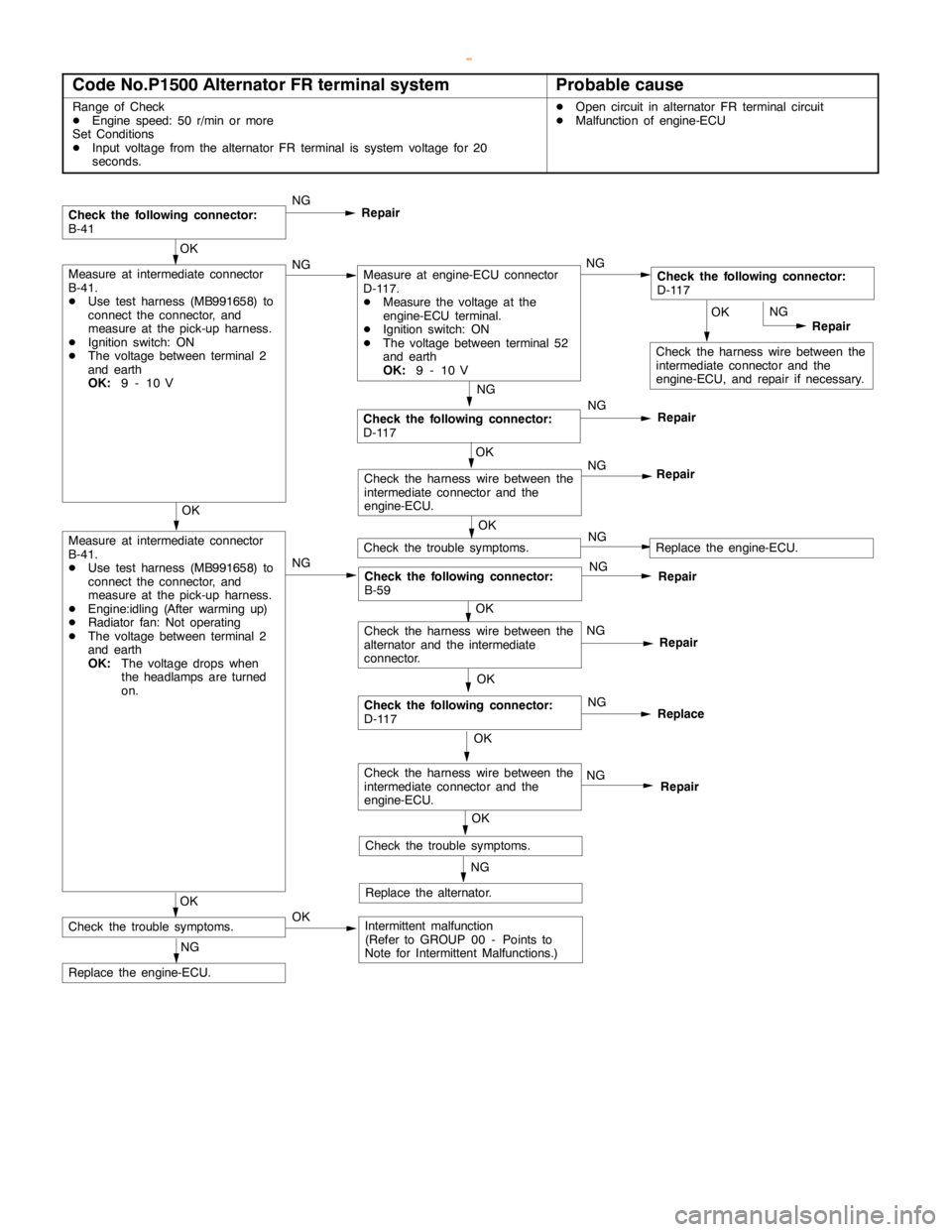
GDI -Troubleshooting
Code No.P1500 Alternator FR terminal systemProbable cause
Range of Check
DEngine speed: 50 r/min or more
Set Conditions
DInput voltage from the alternator FR terminal is system voltage for 20
seconds.DOpen circuit in alternator FR terminal circuit
DMalfunction of engine-ECU
OK
Check the harness wire between the
intermediate connector and the
engine-ECU, and repair if necessary.NG
Repair
NG
Check the following connector:
D-117NG
Repair
Check the following connector:
B-41NG
Repair
OK
Measure at intermediate connector
B-41.
DUse test harness (MB991658) to
connect the connector, and
measure at the pick-up harness.
DEngine:idling (After warming up)
DRadiator fan: Not operating
DThe voltage between terminal 2
and earth
OK:
The voltage drops when
the headlamps are turned
on.NG
Check the following connector:
B-59NG
Repair
OK
Check the trouble symptoms.
NG
Replace the engine-ECU.
OK
Check the harness wire between the
intermediate connector and the
engine-ECU.NG
Repair
OK
Measure at intermediate connector
B-41.
DUse test harness (MB991658) to
connect the connector, and
measure at the pick-up harness.
DIgnition switch: ON
DThe voltage between terminal 2
and earth
OK:
9 - 10 VNGMeasure at engine-ECU connector
D-117.
DMeasure the voltage at the
engine-ECU terminal.
DIgnition switch: ON
DThe voltage between terminal 52
and earth
OK:
9 - 10 VNGCheck the following connector:
D-117
OK
NG
Repair
OK
Check the following connector:
D-117NG
Replace
OK
Check the trouble symptoms.NGReplace the engine-ECU.
OK
Check the harness wire between the
intermediate connector and the
engine-ECU.NG
Repair
NG
Replace the alternator.OK
Check the trouble symptoms.OKIntermittent malfunction
(Refer to GROUP 00 - Points to
Note for Intermittent Malfunctions.)
Check the harness wire between the
alternator and the intermediate
connector.
www.WorkshopManuals.co.uk
Purchased from www.WorkshopManuals.co.uk
Page 308 of 1839
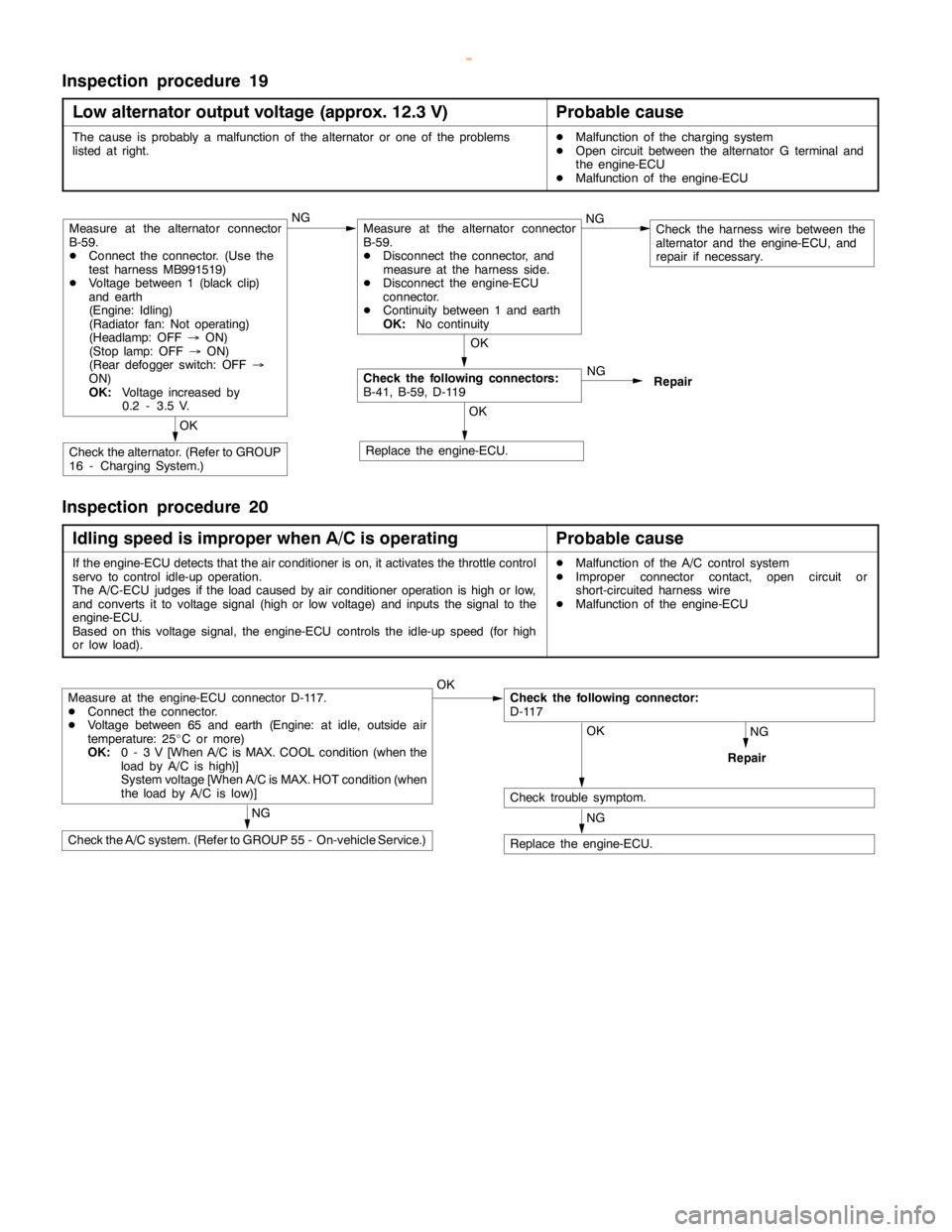
GDI -Troubleshooting
Inspection procedure 19
Low alternator output voltage (approx.12.3 V)
Probable cause
The cause is probably a malfunction of the alternator or one of the problems
listed at right.DMalfunction of the charging system
DOpen circuit between the alternator G terminal and
the engine-ECU
DMalfunction of the engine-ECU
NG
Repair
OK
Replace the engine-ECU.
OK
Check the alternator. (Refer to GROUP
16 - Charging System.)
OK
Check the following connectors:
B-41, B-59, D-119
Measure at the alternator connector
B-59.
DConnect the connector. (Use the
test harness MB991519)
DVoltage between 1 (black clip)
and earth
(Engine: Idling)
(Radiator fan: Not operating)
(Headlamp: OFF®ON)
(Stoplamp: OFF®ON)
(Rear defogger switch: OFF®
ON)
OK:
Voltage increased by
0.2 - 3.5 V.NGMeasure at the alternator connector
B-59.
DDisconnect the connector, and
measure at the harness side.
DDisconnect the engine-ECU
connector.
DContinuity between 1 and earth
OK:
No continuityNGCheck the harness wire between the
alternator and the engine-ECU, and
repair if necessary.
Inspection procedure 20
Idling speed is improper when A/C is operating
Probable cause
If the engine-ECU detects that the air conditioner is on, it activates the throttle control
servo to control idle-up operation.
The A/C-ECU judges if theloadcaused by air conditioner operation ishigh or low,
and converts it to voltage signal (high or low voltage) and inputs the signal to the
engine-ECU.
Based on this voltage signal, the engine-ECU controls the idle-up speed (forhigh
or low load).DMalfunction of the A/C control system
DImproper connector contact,opencircuit or
short-circuited harness wire
DMalfunction of the engine-ECU
NG
Repair
Measure at the engine-ECU connector D-117.
DConnect the connector.
DVoltage between 65 and earth (Engine: at idle, outside air
temperature: 25_C or more)
OK:
0 - 3 V [When A/C is MAX. COOL condition (when the
load by A/C is high)]
System voltage [When A/C is MAX. HOT condition (when
the load by A/C islow)]OKCheck the following connector:
D-117
OK
Check trouble symptom.
NG
Replace the engine-ECU.
NG
Check the A/C system. (Refer to GROUP 55 - On-vehicle Service.)
www.WorkshopManuals.co.uk
Purchased from www.WorkshopManuals.co.uk
Page 327 of 1839

GDI -Troubleshooting
Terminal
No.Normal condition Check requirements (engine condition) Check item
47Power supplyIgnition switch: ONSystem voltage
59
50Camshaft position sensorEngine: Cranking0.4 - 3.0 V
Engine: Idling0.5 - 2.0 V
51Barometric pressure sensorIgnition switch:Altitude: 0 m3.7 - 4.3 V
ON
Altitude: 1,200 m3.2 - 3.8 V
52Alternator FR terminalDEngine: Warm up, and then idling
DRadiator fan: not operating
DHeadlamp: OFF®ON
DStop lamp: OFF®ON
DRear defogger: OFF®ONVoltage decreases
53Oxygen sensor (rear)DTransmission: 2nd gear
DEngine speed: 3,500 r/min or more
DDriving with the throttle valve widely
open0.6 - 1.0 V
54Power steering fluid
pressure switchEngine: Warm
up, and thenSteering wheel
stationarySystem voltage
idling
Steering wheel
turning0-3V
55Injector driver relayIgnition switch: OFF0 - 0.1 V
Ignition switch: ON0.5 - 1.0 V
56Throttle valve control servoIgnition switch: OFF0 - 0.3 V
relay
Ignition switch: ON0.5 - 1.0 V
57Engine control relayIgnition switch: OFF0-3V
Ignition switch: ONSystem voltage
60Back-up power sourceIgnition switch: OFFSystem voltage
61Air flow sensorEngine: Idling2.2 - 3.2 V
Engine: 2,500 r/min
62Intake air temperature
sensorIgnition switch:
ONIntake air temper-
ature: 0_C3.2 - 3.8 V
Intake air temper-
ature: 20_C2.3 - 2.9 V
Intake air temper-
ature: 40_C1.5 - 2.1 V
Intake air temper-
ature: 80_C0.4 - 1.0 V
www.WorkshopManuals.co.uk
Purchased from www.WorkshopManuals.co.uk
Page 367 of 1839
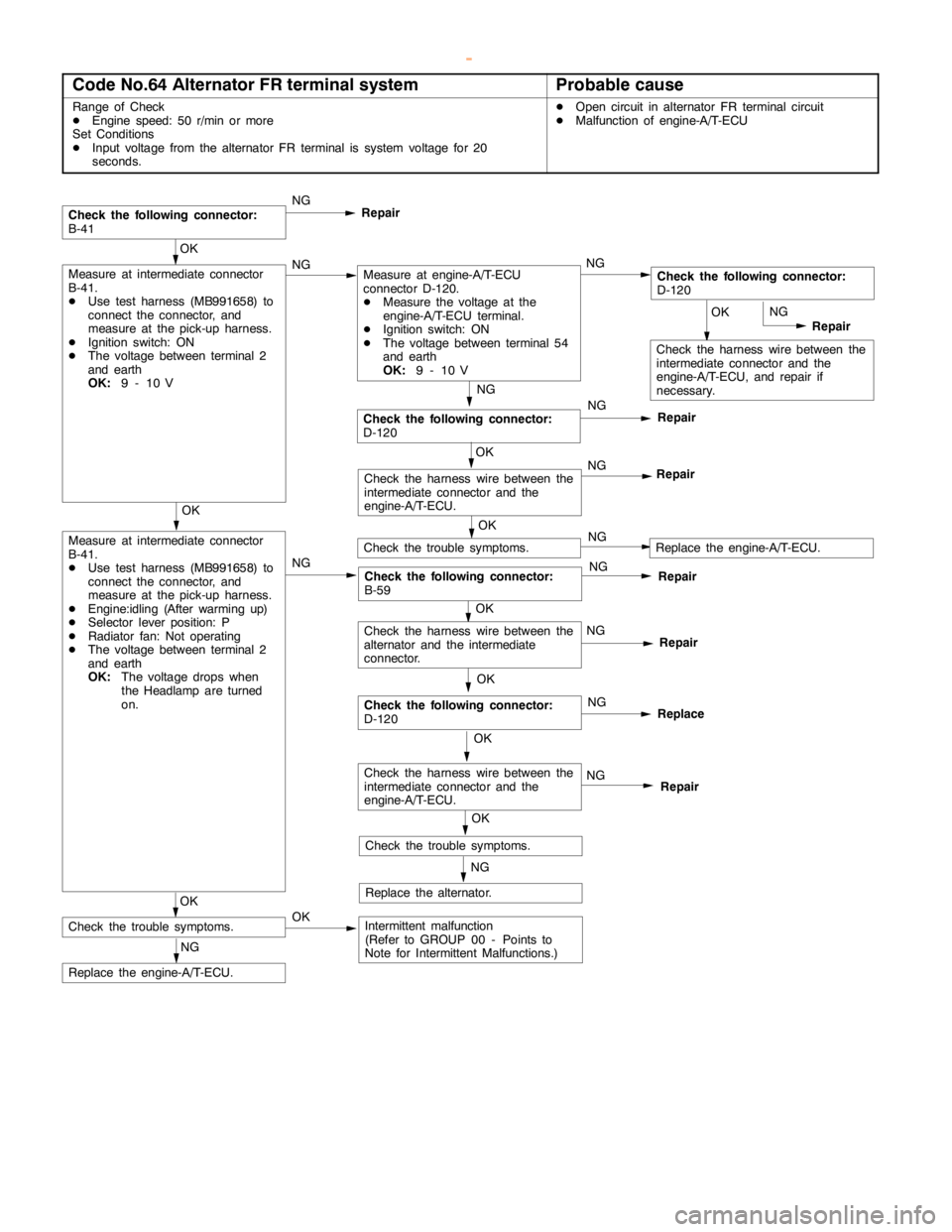
Page 400 of 1839
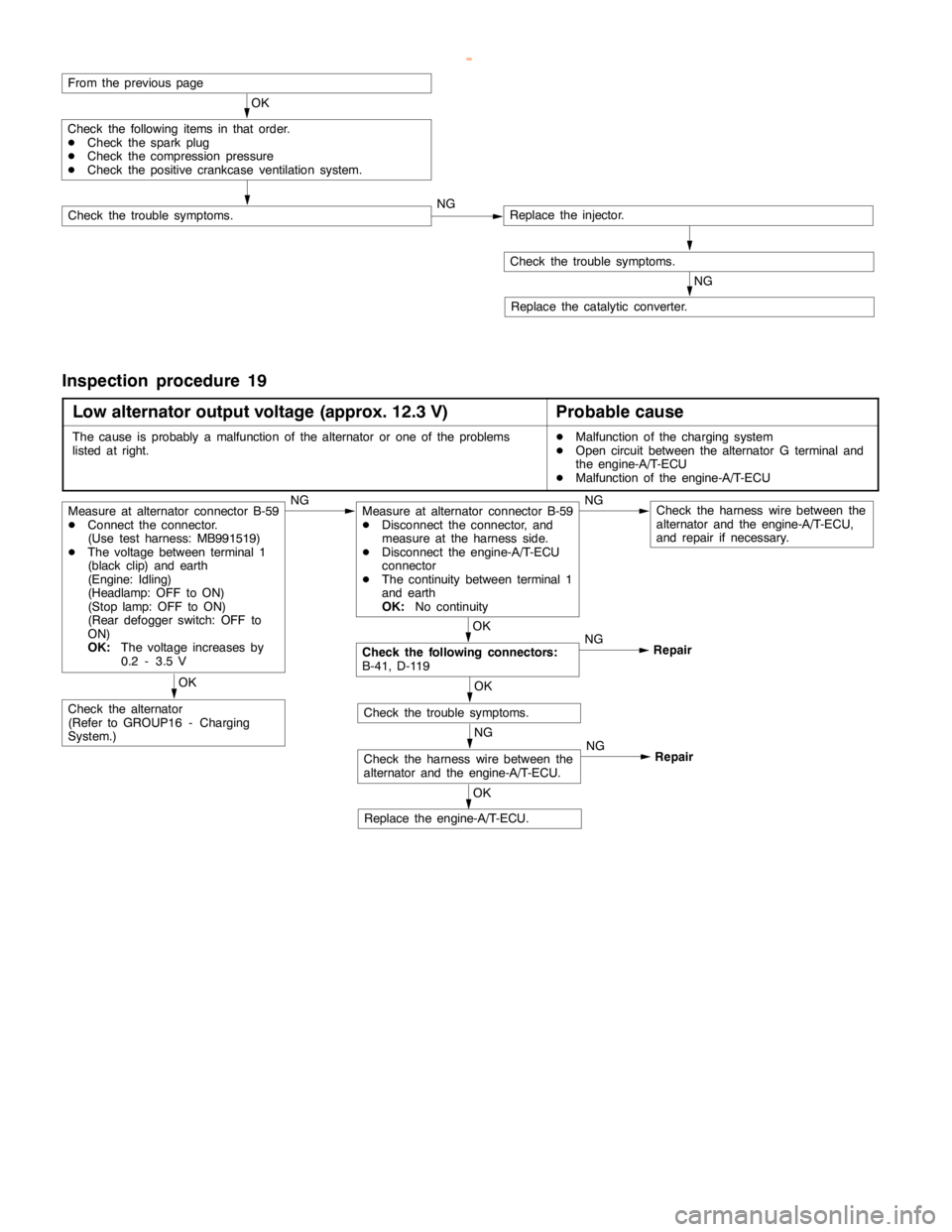
Page 1408 of 1839

51-1
EXTERIOR
CONTENTS
FRONT BUMPER 3.......................
ADHESIVE 3..............................
SPECIAL TOOL 3.........................
FRONT BUMPER 4........................
REAR BUMPER 8........................
ROOF RAIL 11...........................
MOULDING 11...........................
ADHESIVE 11.............................
SPECIAL TOOL 11........................
MOULDING 12............................
GARNISH 16.............................
ADHESIVE 16............................
GARNISH 17.............................
MUDGUARD 19..........................
ADHESIVE 19............................
MUDGUARD 19...........................
REAR DEFLECTOR 21....................
SPECIAL TOOL 21.......................
REAR DEFLECTOR 21....................
SIDE STEP 22...........................
SIDE STEP 22............................
WINDSHIELD WIPER AND WASHER 23....
SERVICE SPECIFICATIONS 23............
TROUBLESHOOTING 23..................
WINDSHIELD WIPER AND WASHER 24...
REAR WIPER AND WASHER 28..........
REFERENCE VALUE 28..................
TROUBLESHOOTING 28..................
REAR WIPER AND WASHER 28..........
HEADLAMP WASHER 30.................
TROUBLESHOOTING 31..................
HEADLAMP WASHER 31.................
CONTINUED ON NEXT PAGE
www.WorkshopManuals.co.uk
Purchased from www.WorkshopManuals.co.uk
Page 1572 of 1839

54A-2
CHASSIS
ELECTRICAL
CONTENTS
BATTERY 4
..............................
SERVICE SPECIFICATIONS 4..................
ON-VEHICLE SERVICE 4......................
Electrolyte Level and Specific Gravity Check 4..
Charging 5.................................
Battery Test 5...............................
IGNITION SWITCH AND IMMOBILIZER
SPECIAL TOOLS 6............................
TROUBLESHOOTING 6........................
IGNITION SWITCH AND
IMMOBILIZER-ECU 11.........................
IGNITION SWITCH AND IMMOBILIZER
<4D56> 14...............................
SPECIAL TOOLS 14...........................
TROUBLESHOOTING 14.......................
IGNITION SWITCH AND IMMOBILIZER-ECU
19 ............................................
COMBINATION METER 23................
SERVICE SPECIFICATIONS 23.................
SEALANTS 24................................
SPECIAL TOOLS 24...........................
TROUBLESHOOTING 24.......................
ON-VEHICLE SERVICE 30.....................
Speedometer Check 30......................
Tachometer Check 30........................
Fuel Gauge Unit Check 31....................Engine Coolant Temperature Gauge Unit Check
32 .........................................
COMBINATION METER 33.....................
HEADLAMP ASSEMBLY 36...............
SERVICE SPECIFICATIONS 36.................
SPECIAL TOOLS 36...........................
TROUBLESHOOTING 36.......................
ON-VEHICLE SERVICE 36.....................
Headlamp Aiming Adjustment 36..............
Luminance Measurement 38..................
Headlamp Bulb Replacement 39...............
HEADLAMP ASSEMBLY 40....................
FOG LAMPS 41..........................
SERVICE SPECIFICATIONS 41.................
SPECIAL TOOLS 41...........................
TROUBLESHOOTING 41.......................
ON-VEHICLE SERVICE 41.....................
Fog Lamp Aiming Check 41...................
FOG LAMPS 44...............................
SIDE TURN-SIGNAL LAMPS 45...........
SPECIAL TOOLS 45...........................
SIDE TURN-SIGNAL LAMPS 46................
ROOM LAMP 46.........................
TROUBLESHOOTING 46.......................
CONTINUED ON NEXT PAGE
www.WorkshopManuals.co.uk
Purchased from www.WorkshopManuals.co.uk
Page 1575 of 1839
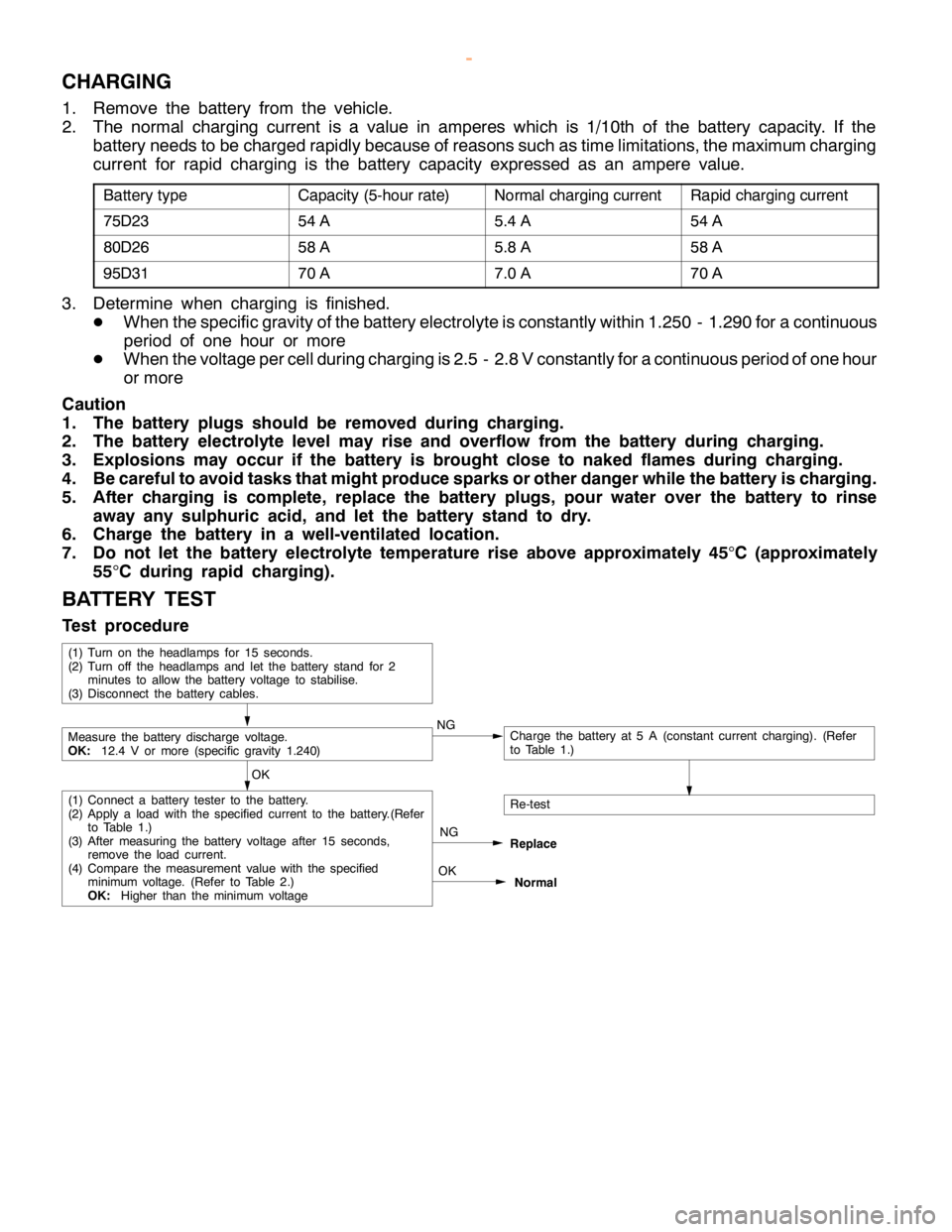
CHASSIS ELECTRICAL-Battery54A-5
CHARGING
1. Remove the battery from the vehicle.
2. The normal charging current is a value in amperes which is 1/10th of the battery capacity. If the
battery needs to be charged rapidly because of reasons such as time limitations, the maximum charging
current for rapid charging is the battery capacity expressed as an ampere value.
Battery typeCapacity (5-hour rate)Normal charging currentRapid charging current
75D2354 A5.4 A54 A
80D2658 A5.8 A58 A
95D3170 A7.0 A70 A
3. Determine when charging is finished.
DWhen the specific gravity of the battery electrolyte is constantly within 1.250 - 1.290 for a continuous
period of one hour or more
DWhen the voltage per cell during charging is 2.5 - 2.8 V constantly for a continuous period of one hour
or more
Caution
1. The battery plugs should be removed during charging.
2. The battery electrolyte level may rise and overflow from the battery during charging.
3. Explosions may occur if the battery is brought close to naked flames during charging.
4. Be careful to avoid tasks that might produce sparks or other danger while the battery is charging.
5. After charging is complete, replace the battery plugs, pour water over the battery to rinse
away any sulphuric acid, and let the battery stand to dry.
6. Charge the battery in a well-ventilated location.
7. Do not let the battery electrolyte temperature rise above approximately 45
°C (approximately
55
°C during rapid charging).
BATTERY TEST
Test procedure
OK
NG
Replace
Re-test
OK
Normal
(1) Connect a battery tester to the battery.
(2) Apply aloadwith the specified current to the battery.(Refer
to Table 1.)
(3) After measuring the battery voltage after 15 seconds,
remove the loadcurrent.
(4) Compare the measurement value with the specified
minimum voltage.(Refer to Table 2.)
OK:Higher than the minimum voltage
Measure the battery discharge voltage.
OK:12.4 V or more (specific gravity 1.240)NGCharge the battery at 5 A (constant current charging). (Refer
to Table 1.)
(1) Turn on the headlamps for 15 seconds.
(2) Turn off the headlamps and let the battery stand for 2
minutes to allow the battery voltage to stabilise.
(3) Disconnect the battery cables.
www.WorkshopManuals.co.uk
Purchased from www.WorkshopManuals.co.uk